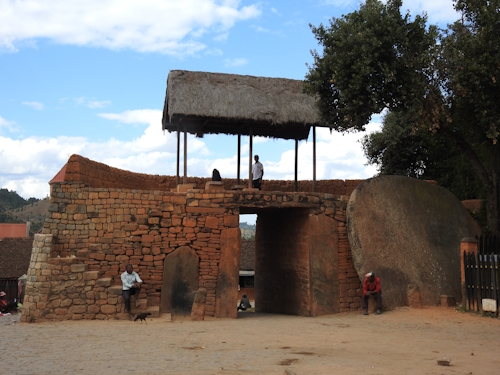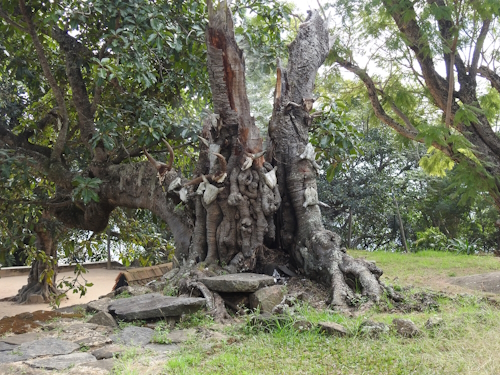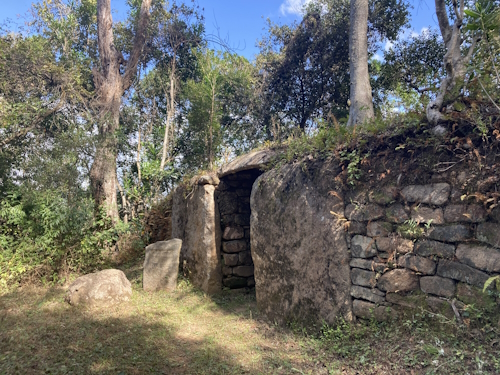Blog WHS Visits
WHS #845: Royal Hill of Ambohimanga
The Royal Hill of Ambohimanga is a fortified hill with great historical and symbolic value for the people of Madagascar. It is a wonderful site to visit as it is in good condition and has so many layers: the first unified Malagasy kingdom, the start of its interaction with the outside world just before colonial times, and a contemporary place of worship. I spent 3 hours there on a guided tour of the palace complex and a forest walk.
Although it lies only 20km away from the Madagascar capital Antananarivo, it will take the best part of an hour to get there by car. Leaving the busy city center is the hardest, after that, a fine drive along the rice paddies follows. Ambohimanga is one of many hills in this area. From viewpoints, you can also see the tomb of the King’s astrologer on the adjacent, slightly higher hill. Also, there are the remains of a palace in between these two hills. The astrologer’s hill is a popular place for local worship, the only way to get there is to walk up.
We started the visit to Ambohimanga after entering via the Royal Gate (photo 1). Local nobility started using this hilltop from the 15th century on, but most of what you now see dates from the early 19th century. The Malagasy royals were a promiscuous bunch, the guide told stories about the Queen that had all her lovers killed or the Prime Minister that ended up marrying three of the queens (the King had 12). The oldest remaining structure is the King’s palace, a traditional Malagasy wooden building, only somewhat larger than the regular houses but with interesting features inside. At the back, the tombs of the ancestors of the first King have been restored and what was left of the human remains has been re-interred, after they had been taken away to Antananarivo by the French in 1897.
The Queen’s palace next door, dating from 1871, has clear European influences. By that time the Malagasy were more aware of the outside world and got connected to foreign royalty. Gifts from Belgium, Spain and the British Queen Victoria have been preserved.
Although the colonial damage done here was brutal (the French wanted to break the Malagasy spirit), it has not destroyed the essence of the site and the residents are clearly proud of it. The slab of stone where the royal zebu were slaughtered is still in place, and yearly offerings continue as can be seen by the newish zebu horns in the collection nailed to the sacred fig tree (photo 2).
The 2-hour forest walk requires an additional entrance fee and a different guide, and it is not always on offer at the site reception. It did provide a deepening of my understanding of the site overall, so I would recommend taking it. The woodland lies within the larger gated enclosure of the Royal Hill and its large variety of plants and trees was maintained for practical and spiritual reasons. It is almost like a botanical garden and parts of it have been there for hundreds of years. Some plants are for medicinal use, others provide leaves for brewing tea, and strong wood species such as the Madagascar rosewood were used for the construction of buildings. Locals may still use the leaves and fruits, but not cut the trees.
The dense forest also served as an extra layer of defense and along the trails you'll encounter old gates and the remains of a deep moat. There was a gate for the common people (photo 3), which was the main access road before the French made the current one via the royal gate. And there was a gate that was only used for carrying up deceased people. All gates have a large stone disc that could be rolled into place to close it. The gates were guarded by armed soldiers and also had hedges on top of the walls.
Finally, I’d like to recommend the little café with a panoramic terrace right at the site’s parking lot. Here they do a fine ‘Porc au Ravitoto’, which has a sauce made of crushed and cooked cassava leaves that tastes a bit like spicy spinach. The taboo on eating pork at the Royal Hill – reinstalled after the devastating cyclone of 2012 - seems not to be stringently adhered to!
Els - 25 June 2023


